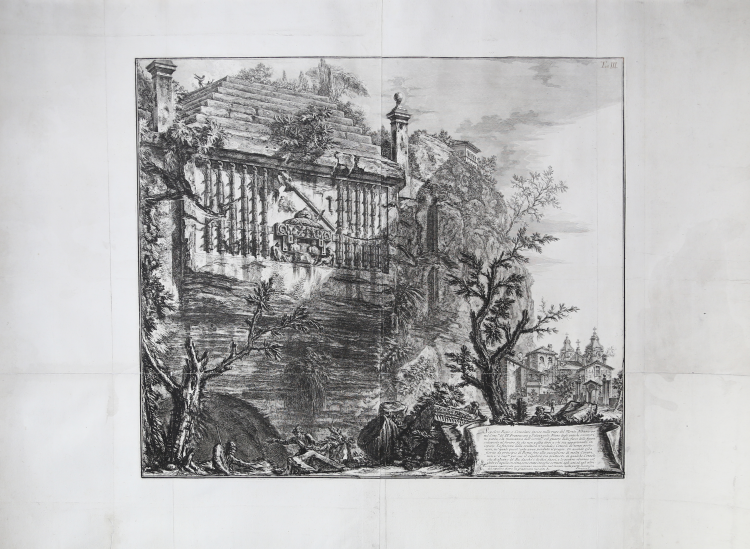



| Reference: | S40680 |
| Author | Giovan Battista PIRANESI |
| Year: | 1764 |
| Zone: | Albano |
| Printed: | Rome |
| Measures: | 650 x 555 mm |


| Reference: | S40680 |
| Author | Giovan Battista PIRANESI |
| Year: | 1764 |
| Zone: | Albano |
| Printed: | Rome |
| Measures: | 650 x 555 mm |
Title: Royal or Consular Tomb Carved into the Rock Face of Mount Albano… (Sepolcro Regio, o Consolare, inciso nella rupe del Monte Albano…)
Etching and engraving, numbered upper right Tav.III.
Signature, lower rigt, on a scroll:
Sepolcro Regio, o Consolare, inciso nella rupe del Monte Albano or / nel Conv. to de' PP. Francescani a Palazzuolo. Niuno degli antichi scrittori / ne parla, e la mancanza dell'iscriz.ne col guasto delle facce delle figure / sottoposte al feretro, fa che non possa dirsi a chi sia appartenuto in / ispecie. La finezza della scultura n' esclude i Consoli de' tempi poste= / riori, né quali quest'arte avea perduto il pregio. Or avendo essa / fiorito da principio di Roma fino alla successione di molti Cesari, / non v'è rag. ne per cui il sepolcro sia piuttosto di qualche Console, / che di alcuno de' Re, dacchè i dodici fasci, e lo scettro eburneo col / globo e l'aquila in cima, sono state insegne comuni agli uni ed agli altri. / La stanza sepolcrale poi rimane incavata nel monte nella parte superiore / del sepolcro dietro la gradinata nel sito A. / Piranesi F.
From the first edition of Antichità d’Albano e di Castel Gandolfo Descritte ed incise da Giovambattista Piranesi Roma, 1764.
Piranesi's archaeological studies in the area of Lake Albano, initiated by his work on the Emissario, were greatly encouraged by Pope Clement XIII whose summer residence at Castel Gandolfo overlooked the lake. At the suggestion of this major patron, who helped to defray the considerable costs, the artist produced a particularly handsome treatise devoted to the local antiquities and dedicated to the Pope. In this work, which is often bound with the works on the Emissario and the Due Spelonche, Piranesi extended his illustrative techniques of combining emotive vedute with highly technical, and often speculative, diagrams on aspects of Roman construction.
|
Focillon, 511; Petrucci, 460, p. 26, 1953; Wilton – Ely 644.
|
Giovan Battista PIRANESI (Mogliano Veneto 1720 - Roma 1778)
|
Italian etcher, engraver, designer, architect, archaeologist and theorist. He is considered one of the supreme exponents of topographical engraving, but his lifelong preoccupation with architecture was fundamental to his art. Although few of his architectural designs were executed, he had a seminal influence on European Neo-classicism through personal contacts with architects, patrons and visiting artists in Rome over the course of nearly four decades. His prolific output of etched plates, which combined remarkable flights of imagination with a strongly practical understanding of ancient Roman technology, fostered a new and lasting perception of antiquity. He was also a designer of festival structures and stage sets, interior decoration and furniture, as well as a restorer of antiquities. The interaction of this rare combination of activities led him to highly original concepts of design, which were advocated in a body of influential theoretical writings. The ultimate legacy of his unique vision of Roman civilization was an imaginative interpretation and re-creation of the past, which inspired writers and poets as much as artists and designers.
|
|
Focillon, 511; Petrucci, 460, p. 26, 1953; Wilton – Ely 644.
|
Giovan Battista PIRANESI (Mogliano Veneto 1720 - Roma 1778)
|
Italian etcher, engraver, designer, architect, archaeologist and theorist. He is considered one of the supreme exponents of topographical engraving, but his lifelong preoccupation with architecture was fundamental to his art. Although few of his architectural designs were executed, he had a seminal influence on European Neo-classicism through personal contacts with architects, patrons and visiting artists in Rome over the course of nearly four decades. His prolific output of etched plates, which combined remarkable flights of imagination with a strongly practical understanding of ancient Roman technology, fostered a new and lasting perception of antiquity. He was also a designer of festival structures and stage sets, interior decoration and furniture, as well as a restorer of antiquities. The interaction of this rare combination of activities led him to highly original concepts of design, which were advocated in a body of influential theoretical writings. The ultimate legacy of his unique vision of Roman civilization was an imaginative interpretation and re-creation of the past, which inspired writers and poets as much as artists and designers.
|